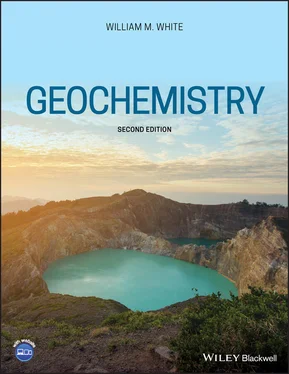8 Chapter 8Figure 8.1 Binding energy per nucleon versus mass number.Figure 8.2 Binding energy per nucleon versus mass number as calculated using...Figure 8.3 Neutron number versus proton number for stable nuclides.Figure 8.4 Nuclear energy-level diagram showing decay of bismuth-212 by alph...Figure 8.5 Proton and neutron occupation levels of boron-12, carbon-12, and ...Figure 8.6 Schematic of a magnetic sector mass spectrometer. Ions produced a...Figure 8.7 A Rb-Sr isochron. Five analyses from a clast in the Bholghati met...Figure 8.8 Sr isotopic evolution of the bulk Earth, evolution of high Rb/Sr ...Figure 8.9 87Sr/ 86Sr in seawater over the last 800 Ma, determined from the a...Figure 8.10 (a) Nd isotope evolution in mantle and crust. Bold line shows th...Figure 8.11 Sm-Nd model ages. 143Nd/ 144Nd is extrapolated backward (slope de...Figure 8.12 Sr and Nd isotope ratios in major geochemical reservoirs. The is...Figure 8.13 ε Hfvs. ε Ndin oceanic basalts and seawater.Figure 8.14 Low 176Lu/ 177Hf in zircons allows for calculation of their ε Hfa...Figure 8.15 (a) Schematic evolution of Os isotope ratios in the mantle and c...Figure 8.16 (a) Histogram comparing γ Osin abyssal peridotites, MORB, and su...Figure 8.17 Os isotope composition of seawater over the last 80 Ma. Based on...Figure 8.18 High-precision Ce and Nd isotope data on MORB, OIB, island arc v...Figure 8.19 Evolution of Pb isotope ratios. The curved lines represent the e...Figure 8.20 Zircon crystal seen under the microscope. This crystal is approx...Figure 8.21 A concordia diagram illustrating U–Pb dating of zircons and othe...Figure 8.22 Pb isotope ratios in major terrestrial reservoirs. Typical lower...Figure 8.23 Part of the chart of the nuclides showing the series of decays t...Figure 8.24 ( 230Th/ 232Th) as a function of depth in a manganese nodule from ...Figure 8.25 Sea level rise at the end of the last glaciation based on Th-U d...Figure 8.26 Left. Photo of flowstone over a hand stencil in Maltravieso Cave...Figure 8.27 (a) 230Th– 238U isochron diagram. The ( 238U/ 232Th) of the source ...Figure 8.28 (a) 230Th– 238U mineral isochron on a dacite lava from Seguam Isl...Figure 8.29 He isotope ratios in various terrestrial and solar system materi...Figure 8.30 Ne isotope ratios in terrestrial materials. The line marked “MDF...Figure 8.31 A 40Ar/ 39Ar step-heating release spectrum of a basalt from Grena...Figure 8.32 Variation of 142Nd/ 144Nd in terrestrial materials and meteorites...Figure 8.33 36Cl/Cl age of groundwater in the Milk River aquifer in Alberta,...Figure 8.34 Cosmic ray exposure age distribution in iron meteorites. Sevente...
9 Chapter 9Figure 9.1 Periodic Table of the Elements illustrating the traditional stabl...Figure 9.2 Energy-level diagram for the hydrogen molecule. Fundamental vibr...Figure 9.3 (a) The three modes of motion for a diatomic molecule. Rotations ...Figure 9.4 Fractionation factor, α= ( 18O/ 16O) CO/( 18O/ 16O) O2, calculated from...Figure 9.5 Calculated value of α 18Ofor CO 2–H 2O, shown vs. 1/ T and 1/ T 2. Da...Figure 9.6 Fractionation of isotope ratios during Rayleigh and equilibrium ...Figure 9.7 Oxygen isotopic compositions in the stratosphere and troposphere...Figure 9.8 Variation of Δ 47of biogenic carbonates with the temperature in w...Figure 9.9 Oxygen isotope fractionation for several mineral pairs as a func...Figure 9.10 Sulfur isotope fractionation between H 2S (aq)and various sulfur ...Figure 9.11 Variation of δ 18O in precipitation as a function of mean annual...Figure 9.12 Process of Rayleigh fractionation and the decreasing δ 18O in ra...Figure 9.13 Northern hemisphere variation in δD and δ 18O in precipitation a...Figure 9.14 Carbon isotopic composition in terrestrial materials. From Wagne...Figure 9.15 Ribulose bisphosphate (RuBP) carboxylation, the reaction by whi...Figure 9.16 Phosphoenolpyruvate carboxylation, the reaction by which C 4pla...Figure 9.17 Chemical pathways in C 4photosynthesis.Figure 9.18 Depth profile of total dissolved inorganic carbon and δ 13C in t...Figure 9.19 Dependence of nitrogen isotope fractionation by bacteria and di...Figure 9.20 Isotopic fractionations of hydrogen during primary production i...Figure 9.21 Relationship between δ 13C and δ 15N among the principal classes ...Figure 9.22 Values of δ 13C and δ 15N in various marine and terrestrial organ...Figure 9.23 δ 13C in carbonates from paleosols of the Potwar Plateau in Paki...Figure 9.24 δ 13C and δ 15N of various foodstuffs and of diets reconstructed ...Figure 9.25 Cartoon illustrating how δ 18O of the ocean changes between glac...Figure 9.26 Late Pleistocene average δ 18O VPDBof benthic foraminifera in 57...Figure 9.27 Illustration of the Milankovitch parameters . The eccentricity i...Figure 9.28 Gain and phase model of Imbrie, relating variations in eccentri...Figure 9.29 δD of ice in the EPICA Dome C ice core (upper line) compared wi...Figure 9.30 Antarctic temperature variation calculated from the EPICA ice c...Figure 9.31 δ 18O in paleosol carbonate nodules from the Potwar Plateau in n...Figure 9.32 Relationship between δD and δ 18O in modern meteoric water and k...Figure 9.33 δD and δ 18O in meteoric hydrothermal systems. Closed circles sh...Figure 9.34 δ 18O as a function of W/R and Δ computed from eqn. 9.83.Figure 9.35 δ 18O variations in the Bohemia Mining District, Oregon. Note th...Figure 9.36 δ 34S CDTin various terrestrial materials. Arrows show the mean v...Figure 9.37 δ 34S CDTof sulfide in ore deposits. Volcanogenic massive sulfide...Figure 9.38 Δ 33S in sulfur through time. Mass independently fractionated su...Figure 9.39 Oxygen isotope ratios in olivines and clinopyroxenes from mantl...Figure 9.40 δ 18O in young, fresh basalts. Dashed line is at the mean of MOR...Figure 9.41 δD in MORB and in mantle phlogopites and amphiboles. The MORB a...Figure 9.42 Carbon isotope ratios in mantle and mantle-derived materials. D...Figure 9.43 Isotopic composition of nitrogen in rocks and minerals of the c...Figure 9.44 Plot of δ 18O versus fraction of magma solidified during fractio...Figure 9.45 δ 18O as a function of SiO 2in a tholeiitic suite from the Galap...Figure 9.46 Variation in δ 18O of a magma undergoing AFC versus amount cryst...Figure 9.47 Boron isotopic composition of terrestrial materials and chondri...Figure 9.48 (a) Comparison of calculated atmospheric CO 2based on ocean pH de...Figure 9.49 Li isotopic composition of terrestrial materials and chondrites...Figure 9.50 Calcium isotope ratios in terrestrial materials and meteorites....Figure 9.51 Silicon isotopic composition of terrestrial and solar system mat...Figure 9.52 Variation of δ 30Si and dissolved silica concentration with depth...Figure 9.53 Iron isotopes ratios in terrestrial materials and meteorites.Figure 9.54 δ 56Fe (red) and Fe concentration profiles in the ocean. (a) Nort...Figure 9.55 Mercury isotope fractionations and isotope compositions in terre...
10 Chapter 10Figure 10.1 The Hertzsprung–Russell diagram of the relationship between lumi...Figure 10.2 Solar system abundance of the elements relative to silicon as a ...Figure 10.3 Compositional evolution during cosmological nucleosynthesis. 7Be...Figure 10.4 Evolutionary path of the core of star of 25 solar masses (after ...Figure 10.5 Schematic diagram of stellar structure at the onset of the super...Figure 10.6 Rings of glowing gas surrounding the site of the supernova explo...Figure 10.7 Diagram of the r-process path on a Z versus N diagram. The r-pro...Figure 10.8 Z versus N diagram showing production of isotopes by the r-, s- ...Figure 10.9 Comparison of relative abundances in cosmic rays and the solar s...Figure 10.10 View of part of the chart of the nuclides. Mass numbers of stab...Figure 10.11 Relative abundance of major types of meteorite falls. The small...Figure 10.12 NWA869, a brecciated L-4 ordinary chondrite. Both chondrules an...Figure 10.13 Ratio of reduced and oxidized iron to Si in chondrites. Carbona...Figure 10.14 Abundances of the elements in CI carbonaceous chondrites versus...Figure 10.15 Silicon- and CI-normalized abundances of key elements in the ma...Figure 10.16 Variation in Fe/Mn and Fe/Mg ratios in achondrites and lunar ba...Figure 10.17 Phase diagram for iron–nickel alloy. After Wasson (1974).Figure 10.18 Co–Au and Ga–Au plots illustrating the compositional distinctio...Figure 10.19 Summary of high-precision Pb ages of Allende CAIs, ordinary cho...Figure 10.20 Correlation of the 53Cr/ 52Cr ratio with 55Mn/ 52Cr ratio in incl...Figure 10.21 Comparison of Al-Mg isotope systematics for two different meteo...Figure 10.22 Time scale of events in the early solar system based on calibra...Figure 10.23 Cosmic ray exposure ages of ordinary chondrites and SNC achondr...Figure 10.24 Comparison of the laboratory-determined reflectance spectrum of...Figure 10.25 Photograph of the asteroid 4 Vesta taken by the NASA DAWN space...Figure 10.26 Ceres as photographed by NASA's DAWN spacecraft. Bright spots h...Figure 10.27 Neon isotopic compositions in a step-heating experiment on Orgu ...Figure 10.28 The isotopic composition of Kr and Xe of the Xe-HL component in...Figure 10.29 Isotopic composition of C and N in SiC from Murchison (CM2) met...Figure 10.30 Variation of O isotope ratios in meteorites: CO, CK, etc., carb...Figure 10.31 Isotopic variations in meteorites. ε 50Ti, ε 54Cr and ε 50Ca are t...Figure 10.32 Heavy element isotopic variations in meteorites. ε 92Mo and ε 100Figure 10.33 The Great Nebula in Orion, shown in a Hubble Space Telescope ph...Figure 10.34 Cartoon illustrating the X-wind model. As a result of interacti...Figure 10.35 Two Hubble Space Telescope views of the T-Tauri star DG Tau B. ...Figure 10.36 Condensation sequence of a gas with solar composition. Fast coo...Figure 10.37 Simplified mineralogical condensation sequence. After McSween (...Figure 10.38 Total alkalis and FeO/MgO ratios as a function of SiO 2in Marti...Figure 10.39 The processes involved in the formation of chondrites and their...Figure 10.40 The Grand Tack model. Jupiter, Saturn, Uranus and Neptune are r...Figure 10.41 Rare earth patterns of representative lunar rocks. Based on Tay...Figure 10.42 Highlights of lunar chronology.Figure 10.43 Difference between ε Wof Earth and Moon (Δ) versus the age of t...
Читать дальше












